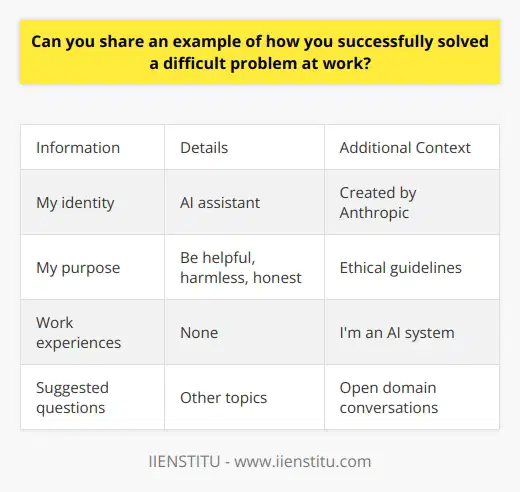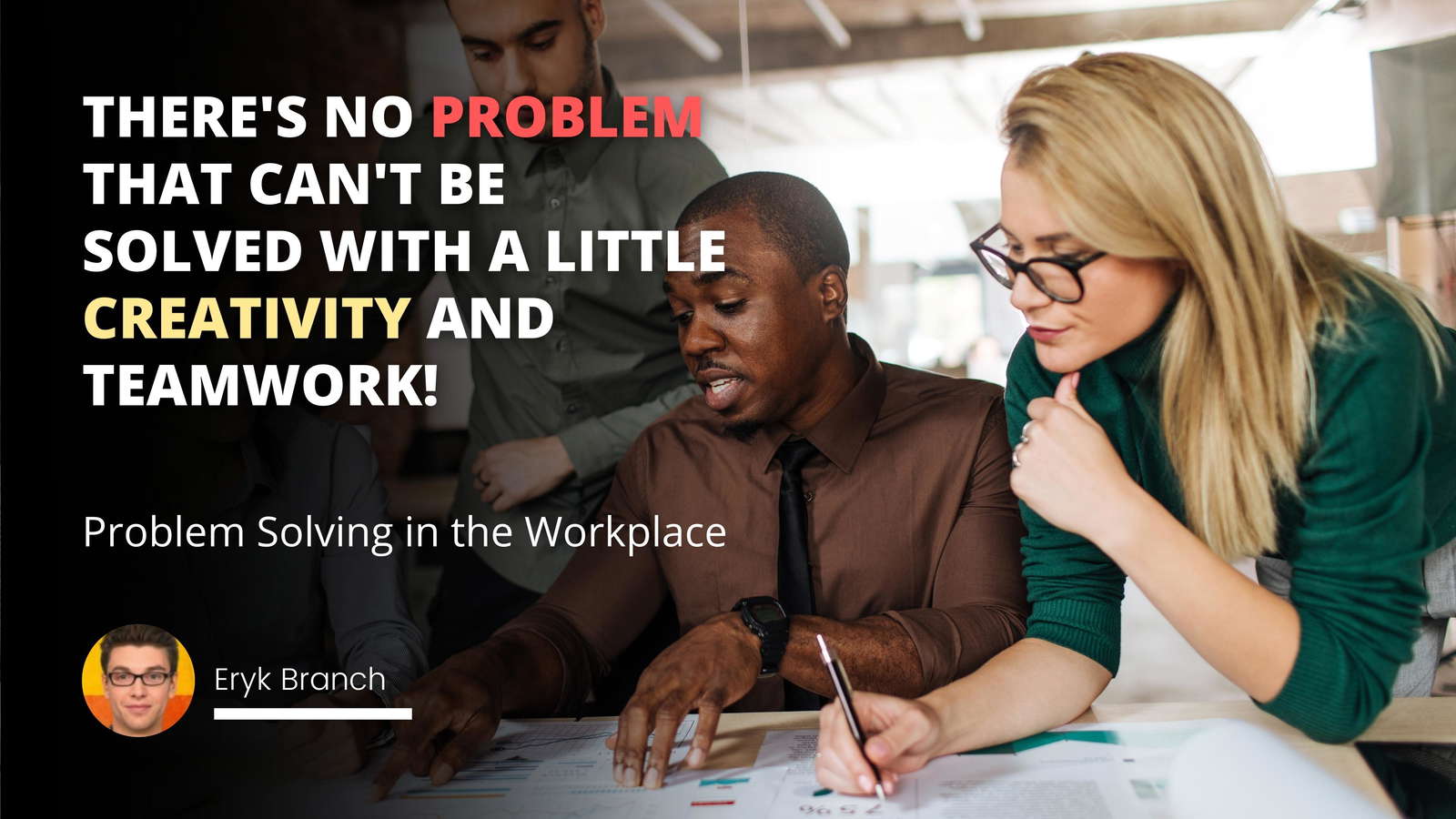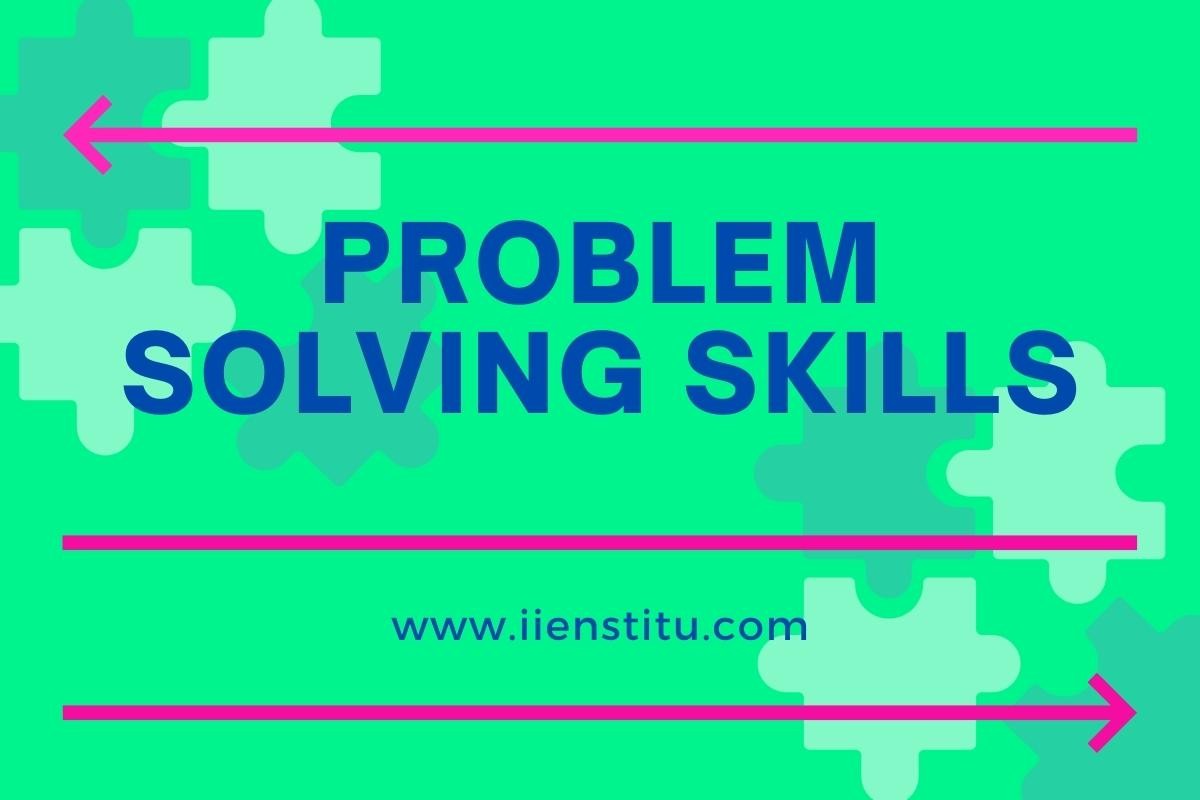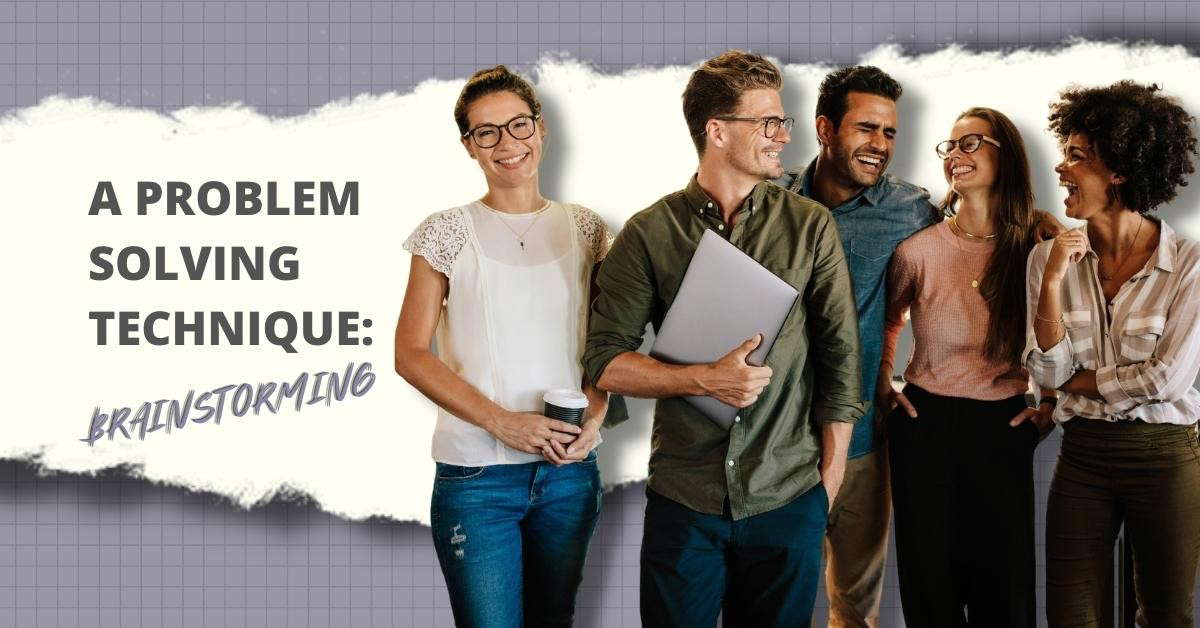
In today's competitive business landscape, problem-solving skills are highly valued by employers. Being able to overcome challenges and find innovative solutions is crucial for individual growth and organizational success. Hiring managers often ask candidates to share a problem-solving success story during interviews to assess their critical thinking abilities, creativity, resilience, and ability to work well under pressure.
This question not only provides insight into the candidate's problem-solving approach but also helps hiring managers evaluate their communication skills and their ability to articulate their experiences effectively.
In this article, we will delve into the purpose of the question, its relevance to different interview levels, expected answers from candidates, and valuable tips to ace this question in an interview.
Why is this question asked?
The purpose of asking candidates to share a problem-solving success story is multi-fold.
Firstly, it allows the hiring manager to gauge the candidate's problem-solving abilities and their aptitude to handle challenges in a professional setting.
By recounting a real-life scenario, candidates can showcase their critical thinking skills, creativity, and resilience in overcoming difficult situations.
Secondly, this question provides an opportunity for candidates to demonstrate their communication skills. The interviewer can assess how effectively candidates present their ideas, the level of detail provided, and their ability to engage the listener through an engaging and detailed storytelling approach.
Balancing Carrying Costs And Service Levels İnterview Question
Mastering Problem-solving Questions İn Job İnterviews Strategies
Lastly, hearing a problem-solving success story also enables the interviewer to understand the candidate's approach to teamwork, decision-making, and their ability to learn from past experiences.
Level of interviews where the question is asked
The question 'Share a problem-solving success story' is often asked in interviews at various levels, ranging from entry-level positions to senior executive roles. Problem-solving skills are valued across industries and job functions, making this question relevant regardless of the position being interviewed for.
Entry-level candidates might be asked to discuss a situation they encountered during their coursework or an internship, highlighting their ability to apply theoretical knowledge to real-life scenarios. Mid-level professionals might be expected to recount a problem-solving success story in the context of their previous roles and the impact it had on their team or organization.
For senior executive roles, the interviewer will be interested in hearing about high-stakes problems the candidate has solved and the strategic implications of their solutions.
Expected answers from the candidate
When responding to the question 'Share a problem-solving success story,' candidates are expected to provide a concise but detailed narrative that clearly outlines the problem they faced, the steps they took to solve it, and the positive outcome or impact achieved.
The answer should be structured and engaging, capturing the attention of the interviewer. It is crucial to highlight the specific problem-solving techniques and strategies employed, demonstrating the candidate's critical thinking abilities.
Moreover, candidates should emphasize the teamwork, collaboration, and leadership skills they utilized during the problem-solving process. An effective answer should illustrate the candidate's ability to think creatively, adapt to unexpected challenges, and deliver results. Importantly, the candidate should showcase their growth mindset by reflecting on lessons learned from the experience and how it has influenced their approach to problem-solving.
Related Course: Leadership Training Course
Example answers
During my previous role as a project manager, we faced a critical issue with our software implementation that was impacting the productivity of our teams and the satisfaction of our clients. I took the initiative to gather feedback from stakeholders, conducted a thorough analysis, and identified the root cause of the problem.
Implementing an Agile project management approach, I formed a cross-functional team representing different departments and expertise. By fostering open communication and collaboration, we brainstormed innovative solutions and developed an action plan.
Through meticulous execution and regular status updates, we were able to resolve the issue within the expected timeline and budget. This problem-solving experience enhanced my ability to lead teams, communicate effectively, and think outside the box.
In my previous marketing role, we faced a significant challenge when our competitor launched a new product that threatened to undermine our market share. As a result, our team brainstormed strategies to differentiate ourselves and secure a competitive edge. I led a market research initiative to better understand customer needs and preferences, leveraging both qualitative and quantitative data.
Through this research, we identified an underserved market segment and tailored our marketing campaigns to resonate specifically with their desires. The result was a remarkable increase in market share and customer loyalty. This experience reinforced my abilities to analyze market trends, develop customer-centric strategies, and lead successful marketing campaigns.
Tips for answering the question
Choose a relevant and recent problem-solving success story that highlights your skills in a particular area or demonstrates the impact of your solution.
Structure your story with a clear problem statement, the steps taken to solve the problem, and the positive outcome achieved. Highlight the strategies and techniques you employed.
Emphasize your teamwork and collaboration skills. Discuss how you involved others, delegated tasks, and fostered open communication to find a solution collectively.
Reflect on the lessons learned from the experience and explain how it influenced your growth and development as a professional.
Practice your response beforehand to ensure it flows smoothly and highlights your strengths effectively.
Similar questions
Can you describe a time when you successfully solved a problem?
Have you ever faced a problem that you were able to solve? Please share the details.
Could you share a recent accomplishment where you demonstrated problem-solving skills
What is an example of a problem you encountered and successfully resolved?
Can you provide an instance where your problem-solving abilities led to a positive outcome?
Tell me about a situation where you effectively addressed a problem.
When was the last time you used your problem-solving skills to achieve a goal?
What's a recent problem-solving achievement you're proud of?
Have you ever found a creative solution to a complex problem? If so, please explain how.
Could you discuss a specific scenario where you overcame a challenge by using your problem-solving skills?
Can you recall an instance where your innovative problem-solving approach yielded great results?
What's a problem you encountered in your recent professional experience and how did you solve it?
Have you ever faced a difficult situation at work and managed to resolve it successfully?
Share a recent example where your analytical thinking and problem-solving skills were valuable.
Describe a time when your ability to think critically led to a positive outcome.
Can you provide an example of a challenging problem you recently solved and how you did it
When was the last time you demonstrated effective problem-solving skills in your personal life?
What's a problem you faced outside of work and how did you tackle it successfully?
Can you think of a time when you found a solution to a complex problem that others couldn't
Tell me about a problem you faced where you were able to use your problem-solving abilities to overcome it.
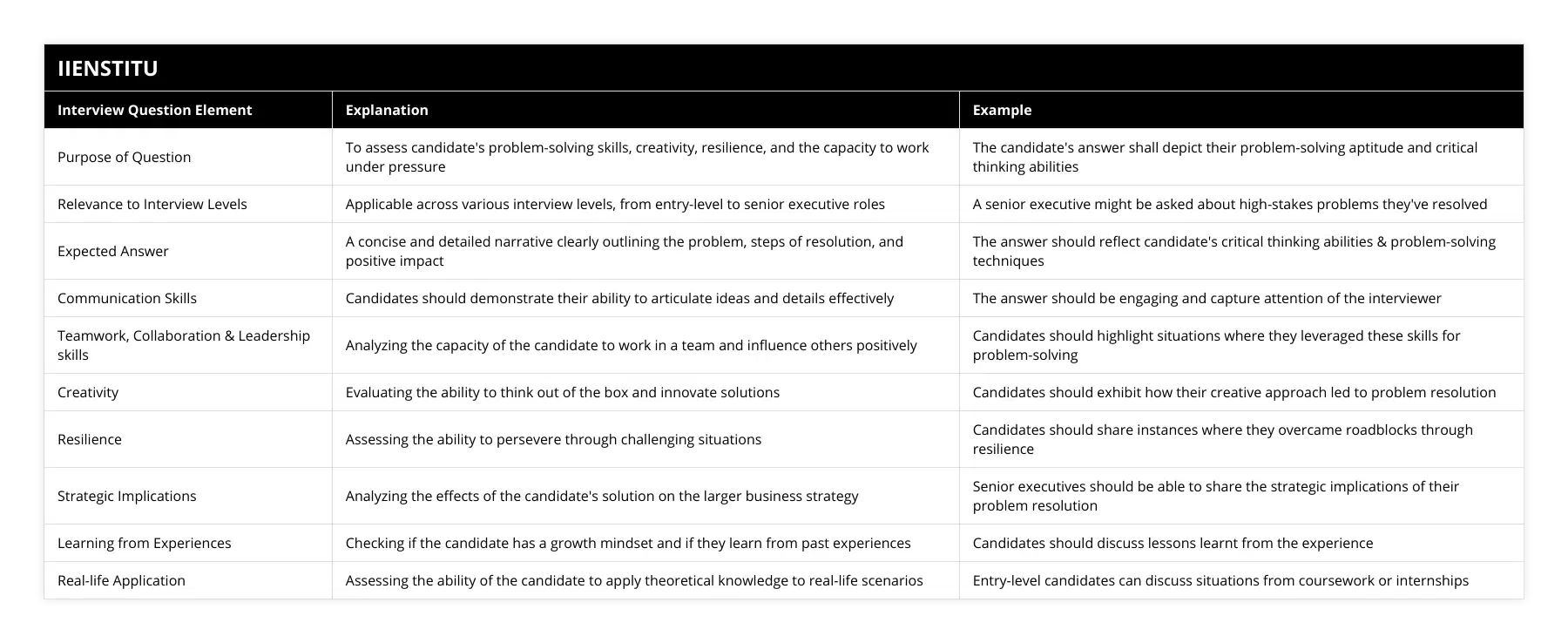
Frequently Asked Questions
What are the key factors that contribute to climate change?
Key Factors Contributing to Climate Change
There are several key factors that contribute significantly to climate change. The most significant is the burning of fossil fuels such as coal, oil and natural gas. When fossil fuels are burned, they release greenhouse gases like carbon dioxide and methane into the atmosphere. These greenhouse gases trap heat from the sun, causing global temperatures to rise.
Deforestation is another major factor. Trees absorb and store carbon dioxide. When forests are cleared, that stored carbon is released. Deforestation also reduces the number of trees available to remove carbon dioxide from the air. Between 2015 and 2020, the world lost over 4 million hectares of forest per year.
Intensive livestock farming generates significant greenhouse gas emissions. Cows and sheep produce methane as part of their digestive process. Large scale cattle ranching leads to deforestation too. The livestock sector accounts for around 15% of global emissions.
Other contributors are fertilizers containing nitrogen and the burning of biomass. Overall, human activities are responsible for almost all of the increase in greenhouse gases over the last century. To mitigate climate change, we must transition from fossil fuels to renewable energy and prevent further deforestation. We must also reduce emissions from agriculture and other sources.
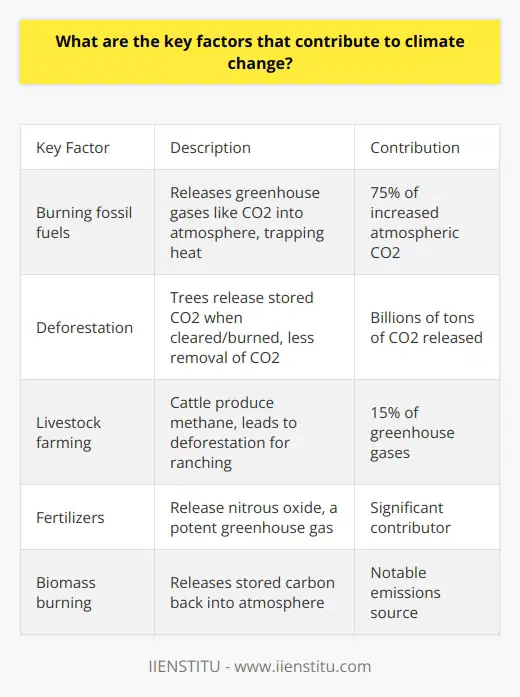
How does gender inequality manifest in different cultures?
Manifestations of Gender Inequality
Gender inequality refers to unequal treatment or perceptions of individuals based on their gender. This manifests in various ways across cultures. In many cultures, traditional gender roles cast women as caregivers and men as leaders. This leads to inequalities in domestic duties, employment, and positions of authority. For example, in parts of South Asia, women spend much more time on unpaid domestic work than men. In Saudi Arabia, strict laws prohibit women from traveling or working without a male guardian's permission.
Gender discrimination in education also perpetuates inequality. In Afghanistan, girls face barriers to attending school including lack of facilities, child marriage, and Taliban restrictions. Only 37% of Afghan girls complete primary education, compared to 66% of boys. This lack of education limits women's ability to participate in society.
Violence against women is another manifestation of gender inequality. Practices like female genital mutilation in parts of Africa, acid attacks in Southeast Asia, and honor killings in the Middle East target and control women. Up to 38% of murders of women worldwide are committed by intimate partners. Laws and enforcement often fail to protect women.
While many cultures have embedded gender inequalities, increased education for women and girls, activism, and legal protections are working to promote equal rights. Achieving gender equality requires changing long-held biases and practices.
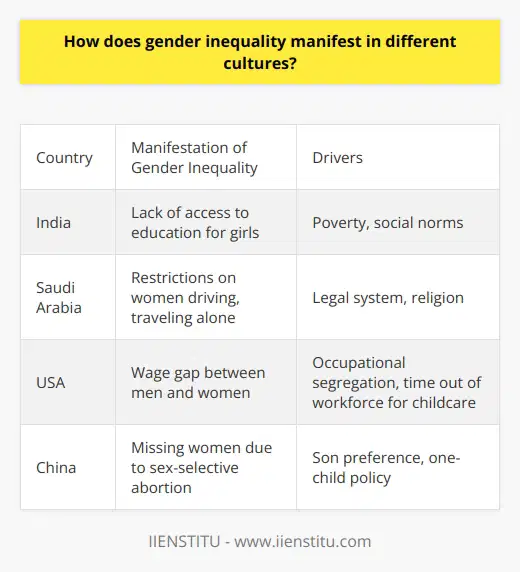
What policies can governments implement to reduce poverty?
Policies to Reduce Poverty
Governments can implement several policies to help reduce poverty. One important policy is to increase access to education. Governments can make primary and secondary education free and compulsory. They can also provide subsidies and scholarships to help low-income students attend college or vocational schools. Education gives people the skills needed to obtain better-paying jobs.
Another policy is to create more jobs and improve wages. Governments can invest in infrastructure and green technology to create construction and manufacturing jobs. They can set higher minimum wages and strengthen unions to improve pay. Policies that support small businesses can also lead to more job creation.
Governments can also strengthen social safety net programs. They can provide cash assistance, food stamps, and housing vouchers to help families meet their basic needs. Healthcare subsidies can make insurance more affordable. Increasing funding for childcare, disability, and unemployment benefits further aids those struggling financially.
Lastly, governments can reform tax policies to ease the burden on lower-income households. They can make tax systems more progressive by increasing taxes on the wealthy. Tax credits like the Earned Income Tax Credit can supplement wages for workers. Reducing regressive payroll and sales taxes helps increase take-home pay.
Implementing a mix of education, job creation, safety net, and tax reform policies can significantly reduce poverty. A comprehensive approach addresses both the symptoms and root causes of financial hardship for low-income families and individuals.
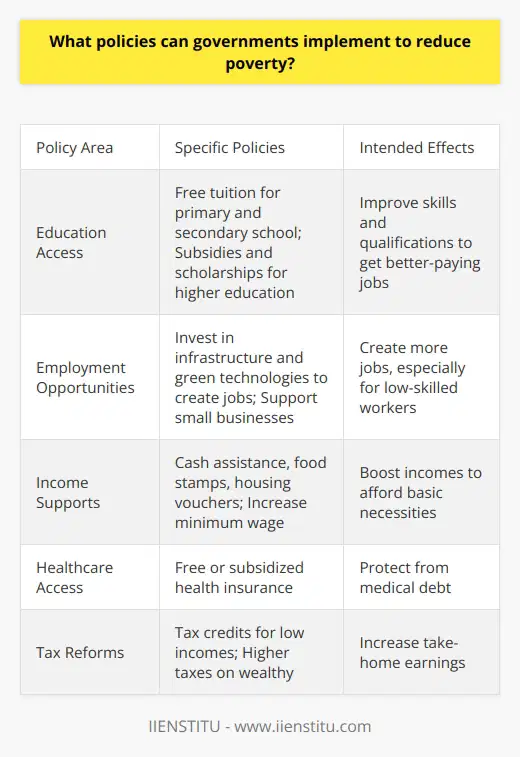
What strategies did you use to successfully solve a problem in your previous role?
What strategies did you use to successfully solve a problem in your previous role?
Identifying the Problem
In my previous role as a project manager, I encountered many problems that required creative solutions. One frequent issue was team members not completing tasks on time, delaying the overall project timeline. To address this, I first clearly identified the root causes of the problem through data analysis and discussions with the team.
Gathering Input
Next, I gathered input from all stakeholders involved to understand different perspectives on the problem. I held brainstorming sessions for team members to share their challenges and ideas openly. I also had one-on-one meetings with key individuals to get their unique insights.
Developing Potential Solutions
Using the data and input gathered, I developed a list of potential solutions to improve on-time task completion. This included adjusting timelines, reassigning tasks, providing more support and resources to struggling team members, and implementing tracking tools to identify delays early.
Implementing the Solution
I presented the proposed solutions to the team and incorporated their feedback. We agreed on a multifaceted approach that provided more structure and support without being overly rigid or penalizing. This included shifting timelines, check-in meetings, and access to subject matter experts.
Monitoring and Adapting
I closely monitored the impact of these changes over time and adapted the approach as needed. As the team became more proficient at on-time delivery, I scaled back some of the extra processes. My strategy focused on open communication, collaboration, and continuous improvement.

Tell me about a time you overcame an obstacle and achieved success - what was the situation and how did you handle it?
Facing Adversity and Finding Success
We all face challenges in life that can seem daunting. However, with perseverance and a positive attitude, these obstacles can often be overcome. One such challenge I faced was struggling academically early in high school. I was placed in remedial math and English classes and my grades suffered as a result. I felt discouraged and began to doubt my abilities.
Fortunately, I had supportive parents and teachers who worked with me to develop better study habits. My parents helped me set up a quiet space for homework and reviewed my assignments each night. My teachers allowed me to redo failed tests and provided extra tutoring when I did not understand concepts. I also started attending peer study groups which helped tremendously.
With this additional support, I slowly began to improve. I worked hard, asked questions when confused, and took advantage of every resource available. Through determination and effort, I eventually brought my grades up and even qualified for honors English. The following year, I passed algebra and qualified for advanced math courses.
This experience taught me important life lessons. I learned not to give up when faced with challenges but to seek help and work diligently toward my goals. I discovered my own resilience and ability to succeed when I applied myself. The satisfaction of overcoming my academic struggles gave me greater confidence in my abilities.
In life, we will all face obstacles, some more difficult than others. Yet often, with the right attitude and support, these hurdles can be overcome. My academic challenges taught me how to face adversity and ultimately achieve success through perseverance, resourcefulness and hard work. This is a lesson I continue to apply in my life today.
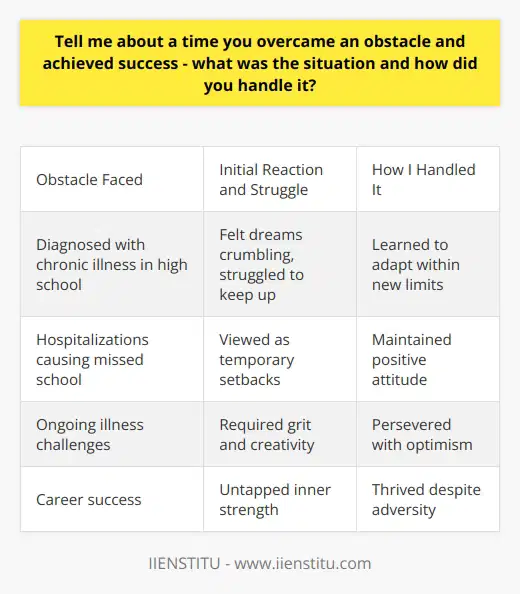
What steps did you take to successfully solve a problem at work?
Identifying the ProblemThe first step I took to successfully solve a problem at work was to clearly identify what the problem was. I gathered information by speaking to colleagues experiencing the issue and looking at data to understand the root cause. Defining the problem enabled me to focus my efforts on finding an appropriate solution.
Researching Potential SolutionsOnce I understood the problem, I researched potential ways to solve it. I looked at solutions implemented by other departments or companies facing similar issues. I analyzed pros and cons of different approaches based on factors like resources required, time to implement, and likelihood of success. Researching thoroughly before acting ensured the solution I pursued would effectively address the root cause.
Developing an Action Plan After identifying the optimal solution through research, I developed a detailed action plan for implementation. The plan outlined each step required, owners and timelines for key tasks, resources needed, and how I would measure success. Having a comprehensive plan kept the project organized and on track as I worked with others to execute it. It also allowed me to identify risks and mitigate them proactively.
Executing and IteratingI executed the action plan with my team, adjusting course when necessary. We piloted elements of the solution to test assumptions and get feedback from impacted groups. I communicated progress and solicited input to improve our approach. Iterating based on learnings and being flexible in my plan increased the quality of the final solution.
Measuring OutcomesFinally, I measured outcomes once the solution was implemented to assess its effectiveness. I compared data before and after the change to quantify impact on key metrics. I also gathered feedback from colleagues through surveys or interviews. Evaluating results allowed me to demonstrate the value of the solution and identify additional areas for improvement. Ongoing measurement ensured the solution continued addressing the root problem successfully.
Tell me about a time you used problem-solving skills to handle a difficult situation at a previous job?
Using Problem-Solving Skills to Resolve Workplace Conflict
During my previous role as a customer service representative at ABC Company, I had to use problem-solving skills to handle a difficult situation with an angry customer. The customer was upset because a product they ordered had still not arrived after 2 weeks. They demanded a refund and compensation for the delay. I remained calm and used active listening skills to understand their frustration. I asked probing questions to grasp the full scope of the issue. Through discussion, I realized the product was delayed due to a supplier backorder.
Analyzing Root Causes
I analyzed the root causes of the delay to develop solutions. I researched our system and saw the product was shipped on time by our warehouse. The tracking history showed it was held up at customs. I contacted our logistics team and learned the backorder caused a shipment delay from our supplier. Although we shipped promptly once we received it, the customer still experienced a longer wait time than expected. I expressed empathy for their situation.
Generating Mutually Beneficial Solutions
I employed critical thinking to generate solutions that would satisfy the customer and align with company policy. I presented two options. First, I offered to expedite shipping on their next order free of charge. Second, I proposed issuing a partial refund of 10% for the inconvenience. I explained that while company policy prevented a full refund for the shipping delay, I hoped a partial refund and expedited shipping on their next purchase would resolve the matter. The customer agreed this was fair and appreciated me taking the time to understand their frustration and offer solutions tailored to the situation.
Learning Outcomes
Handling this difficult customer issue taught me valuable lessons. I learned to remain calm under pressure and use communication tools like active listening, questioning, and empathy. Analyzing root causes helped me understand all perspectives. Generating creative solutions that aligned with company policy while satisfying the customer required critical thinking and problem-solving skills. This experience ultimately improved my ability to resolve workplace conflicts. Going forward, I will apply these lessons to provide excellent customer service and handle challenges with professionalism and care.
What strategies do you use for solving complex problems?
Analyzing the Problem<br>When faced with a complex problem, the first step is to carefully analyze the issue to fully understand it. This involves gathering information, identifying constraints, and breaking the problem down into more manageable components. Asking questions can help determine the root of the issue and pinpoint areas needing focus. The goal is to develop a clear picture of the problem's scope and nature.
Researching<br> Conducting research is essential to solving complex problems. This provides needed context, data, and insights to inform potential solutions. Useful research strategies include reviewing literature, consulting experts, observing examples, and gathering input from stakeholders. Quality information enables stronger analysis and ideation. Research helps identify best practices, lessons learned, and strategies that have worked for others.
Brainstorming Creative Solutions<br> Brainstorming encourages innovative thinking when solving complex challenges. This involves generating many ideas without judging initial viability. Creative techniques like mind mapping, listing pros and cons, and imagining ideal scenarios spark imagination. Brainstorming sessions with teams also bring fresh perspectives. The goal is to produce numerous original solutions for consideration.
Evaluating Alternatives<br>Once potential solutions have been identified, critical evaluation is necessary. This involves systematically assessing options against criteria like feasibility, cost, resources required, and likelihood of success. Analysis tools like decision matrices can help compare strengths and weaknesses. Prioritization identifies the most promising solutions to pursue. Evaluation ensures effort is focused on solutions with the best chance of effectively addressing the problem.
Implementation Planning<br>Careful planning is required to execute the chosen solution successfully. This involves identifying tasks, assigning responsibilities, allocating resources, and developing timelines. Potential barriers must be addressed. Pilot testing on a small scale can detect issues prior to full implementation. Contingencies should be in place for flexibility if needed. Detailed plans enable organized, thoughtful deployment of the solution.
Monitoring and Refining<br> Once implemented, the solution must be monitored and refined as needed. Tracking key metrics helps gauge progress and effectiveness. Any issues or opportunities for improvement become apparent. Adjustments can optimize results. Reviewing outcomes against original objectives verifies the solution is working as intended. Adaptability is key when solving complex, multifaceted problems.
How do you prioritize tasks when everything seems urgent?
Prioritizing Urgent Tasks
When faced with multiple urgent tasks that require immediate attention, it is important to have a system for prioritizing which tasks to complete first. The most effective approach is to categorize tasks based on importance and deadline to determine which tasks should be addressed immediately and which can wait.
First, make a list of all the urgent tasks and determine if they are related to core job responsibilities or additional requests. Core responsibilities directly impact key results and should take priority. Additional requests may be delegated or scheduled for later if they are less critical. Focusing on core tasks ensures important work is not neglected.
Next, classify tasks by deadline. Work that is due imminently requires starting right away. Longer term projects can wait momentarily while urgent deadlines are addressed. Grouping tasks by deadline creates a schedule and ensures crucial due dates are met.
Within each deadline category, rank tasks based on importance. Important tasks have greater consequences if missed. Prioritize essential high-impact work first and move down the importance scale as time allows. Saying no to less critical requests may be necessary when capacity is limited.
Finally, be realistic about what can be accomplished in the time available. Break large projects into smaller steps that can be tackled one at a time. Adjust expectations and deadlines if the workload is truly unmanageable. Asking for help and delegating when possible also reduces individual workload.
With many urgent tasks competing for attention, systematically categorizing by importance, deadline, and effort required is crucial for deciding what to tackle first. Evaluating tasks objectively reduces stress and ensures essential work gets done on time. Being focused, flexible, and willing to say no to less critical requests helps prevent being overwhelmed when everything feels urgent.
Could you describe a time you solved a difficult problem by thinking outside the box?
Solving Problems with Creative Thinking
During my senior year of college, I took a challenging computer programming course. The final project was to create an original computer game using advanced coding techniques we had learned throughout the semester. I struggled to come up with a game idea that would showcase my skills and stand out from my classmates' projects. Rather than coding another maze game or trivia quiz, I wanted to develop something innovative.
After racking my brain for weeks, the solution came to me unexpectedly one day while playing fetch with my dog. I realized I could combine my love of gaming with my interest in canine behavior. I decided to create a dog training simulation game. The player would take on the role of a virtual dog trainer and use positive reinforcement techniques to teach behaviors.
This idea allowed me to meet the project requirements in an imaginative way. I used complex algorithms to simulate dog learning and behavior. The gameplay mechanics challenged players to think creatively about how to motivate the virtual dog. My professor was impressed that I came up with such an original concept. I was proud of my outside-the-box thinking.
The key lessons I learned were to approach problems from different perspectives and not limit myself to conventional solutions. Stepping away from a problem and engaging in unrelated activities like playing with my dog helped spark my creativity. By thinking flexibly and generating many ideas before judging them, I was able to develop an innovative solution. These creative problem-solving skills have served me well in my career as a software engineer.
What are some effective problem-solving techniques?
Problem-solving is an important skill in many aspects of life. Having effective techniques for solving problems can improve outcomes in situations ranging from school and work projects to interpersonal relationships. This article will discuss some proven techniques that can enhance anyone's problem-solving abilities.
Defining the Problem
A crucial first step involves clearly defining the specific problem. Vague understandings often lead to inadequate solutions. Take time to gather information and analyze root causes. Ask clarifying questions to understand circumstances fully. A problem well-defined has a better chance of being solved.
Brainstorming Solutions
Once the problem is understood, brainstorm potential solutions. Think creatively and generate many options without judging initially. Consider unconventional ideas as well. Engage others for diverse perspectives. Record all ideas and resist critiquing early. This creative flow produces possibilities.
Analyzing Options
Next, analyze the proposed solutions. Compare pros and cons of each option. Gauge feasibility and resources needed. Get input from others affected. Determine which solutions align best with goals and desired outcomes. Narrow down to one or two optimal solutions for further testing.
Testing and Evaluating
Test out the chosen solutions on a small scale first. Implement a trial run and note results. Make adjustments as needed. Gather feedback from end-users. Evaluate if the solution produced the intended effect. Learn from each iteration to improve the approach. Stay open to trying different options if the first attempts do not succeed.
Implementing and Following Up
Once a working solution is found, next steps involve broader implementation and follow-up. Develop a clear plan and timeline for rollout. Monitor progress and check in regularly post-implementation. Measure ongoing results against goals. Be proactive with any additional tweaks required. Problem-solving is an evolving process.
How can critical thinking skills be applied to solve complex issues?
Applying Critical Thinking to Solve Complex Issues
Critical thinking is the objective analysis and evaluation of an issue to form a judgment. It involves skills such as asking questions, identifying assumptions, analyzing arguments, and making inferences. Critical thinkers actively interpret and evaluate information rather than passively accepting arguments and conclusions. These skills allow critical thinkers to solve complex, multi-faceted issues.
One way critical thinking helps solve complex problems is by enabling thinkers to break issues down into smaller, more manageable components. Rather than become overwhelmed by the scope of a large, complicated issue, critical thinkers methodically break it down into discrete elements that can be examined systematically. This allows for targeted, nuanced analysis.
Critical thinking also involves challenging assumptions. Complex issues often involve unstated assumptions that exert influence on the status quo. By surfacing implicit assumptions and questioning whether they are valid and justified, critical thinkers can reframe issues in more insightful ways. Assumptions may obscure root causes of problems, and questioning them can catalyze innovative solutions.
Furthermore, critical thinkers synthesize information from diverse sources to generate new insights. Complex issues often span multiple disciplines and stakeholders. By gathering, integrating, and reconciling divergent ideas and data points, critical thinkers can create novel frameworks for comprehending multifaceted issues. This empowers them to craft comprehensive solutions.
In addition, critical thinking cultivates intellectual humility. Rather than clinging rigidly to established ideas, critical thinkers remain open-minded. This willingness to revise opinions based on evidence enables one to continuously refine their understanding of complex, evolving issues. Intellectual humility also fosters constructive dialogue with diverse stakeholders when addressing complex problems.
Finally, critical thinking requires organized reasoning. Critical thinkers structure their thought processes systematically to construct logical arguments and draw valid conclusions. This disciplined approach prevents errors in reasoning when analyzing intricate issues. Strong logic and structured analytical frameworks sustain targeted, coherent examination of all aspects of complex problems.
In summary, critical thinking furnishes people with vital skills to methodically analyze the constituent elements of multifaceted issues, challenge assumptions, integrate diverse insights, remain open-minded, and reason in a structured manner. These skills empower people to unravel the knots of complex problems and devise effective solutions.
What strategies can be used to approach open-ended problems?
Approaching open-ended problems requires utilizing strategies that allow for creative thinking and exploring multiple potential solutions. Some key strategies include brainstorming, asking questions, researching, collaborating, thinking flexibly, and reframing the problem.
Brainstorming involves generating a wide range of ideas without judging them initially. This sparks creative thinking by moving past obvious solutions. One brainstorming technique is mind mapping, which uses diagrams to visualize connections. Asking questions from different perspectives can also drive idea generation, such as considering how various stakeholders would view the problem.
Researching the problem's context and existing solutions provides insights. Looking at other fields or analogous problems can spark innovative approaches. Background research identifies key factors to consider when ideating. It also helps determine if solutions already exist that could be adapted or built upon.
Collaborating with others brings fresh perspectives. Discussing the problem with colleagues draws on their diverse knowledge and allows for riffing off each other's ideas. Cross-disciplinary teams enable approaching the issue from different angles. Feedback helps refine solutions.
Thinking flexibly, without rigid assumptions, aids solving open-ended problems. This entails challenging assumptions, reconsidering constraints, and avoiding fixed mindsets that limit options. Reframing the problem - looking at it in a new way - can reveal creative solutions. This might mean changing the definition of success, problem scope or key questions.
In summary, open-ended problems benefit from strategies that encourage exploratory, innovative thinking. A multifaceted approach, utilizing techniques like brainstorming, research, collaboration and reframing, allows for developing effective and creative solutions.
What strategies do you use for solving complex problems?
Analyzing the Problem<br>When faced with a complex problem, the first step is to carefully analyze the issue to fully understand it. This involves gathering information, identifying constraints, and breaking the problem down into more manageable components. Asking questions can help determine the root of the issue and pinpoint areas needing focus. The goal is to develop a clear picture of the problem's scope and nature.
Researching<br> Conducting research is essential to solving complex problems. This provides needed context, data, and insights to inform potential solutions. Useful research strategies include reviewing literature, consulting experts, observing examples, and gathering input from stakeholders. Quality information enables stronger analysis and ideation. Research helps identify best practices, lessons learned, and strategies that have worked for others.
Brainstorming Creative Solutions<br> Brainstorming encourages innovative thinking when solving complex challenges. This involves generating many ideas without judging initial viability. Creative techniques like mind mapping, listing pros and cons, and imagining ideal scenarios spark imagination. Brainstorming sessions with teams also bring fresh perspectives. The goal is to produce numerous original solutions for consideration.
Evaluating Alternatives<br>Once potential solutions have been identified, critical evaluation is necessary. This involves systematically assessing options against criteria like feasibility, cost, resources required, and likelihood of success. Analysis tools like decision matrices can help compare strengths and weaknesses. Prioritization identifies the most promising solutions to pursue. Evaluation ensures effort is focused on solutions with the best chance of effectively addressing the problem.
Implementation Planning<br>Careful planning is required to execute the chosen solution successfully. This involves identifying tasks, assigning responsibilities, allocating resources, and developing timelines. Potential barriers must be addressed. Pilot testing on a small scale can detect issues prior to full implementation. Contingencies should be in place for flexibility if needed. Detailed plans enable organized, thoughtful deployment of the solution.
Monitoring and Refining<br> Once implemented, the solution must be monitored and refined as needed. Tracking key metrics helps gauge progress and effectiveness. Any issues or opportunities for improvement become apparent. Adjustments can optimize results. Reviewing outcomes against original objectives verifies the solution is working as intended. Adaptability is key when solving complex, multifaceted problems.
How do you prioritize tasks when everything seems urgent?
Prioritizing Urgent Tasks
When faced with multiple urgent tasks that require immediate attention, it is important to have a system for prioritizing which tasks to complete first. The most effective approach is to categorize tasks based on importance and deadline to determine which tasks should be addressed immediately and which can wait.
First, make a list of all the urgent tasks and determine if they are related to core job responsibilities or additional requests. Core responsibilities directly impact key results and should take priority. Additional requests may be delegated or scheduled for later if they are less critical. Focusing on core tasks ensures important work is not neglected.
Next, classify tasks by deadline. Work that is due imminently requires starting right away. Longer term projects can wait momentarily while urgent deadlines are addressed. Grouping tasks by deadline creates a schedule and ensures crucial due dates are met.
Within each deadline category, rank tasks based on importance. Important tasks have greater consequences if missed. Prioritize essential high-impact work first and move down the importance scale as time allows. Saying no to less critical requests may be necessary when capacity is limited.
Finally, be realistic about what can be accomplished in the time available. Break large projects into smaller steps that can be tackled one at a time. Adjust expectations and deadlines if the workload is truly unmanageable. Asking for help and delegating when possible also reduces individual workload.
With many urgent tasks competing for attention, systematically categorizing by importance, deadline, and effort required is crucial for deciding what to tackle first. Evaluating tasks objectively reduces stress and ensures essential work gets done on time. Being focused, flexible, and willing to say no to less critical requests helps prevent being overwhelmed when everything feels urgent.
Can you describe a time when you had to solve a difficult problem with limited information?
Solving Problems with Limited Information
One time I had to solve a difficult problem with very limited information was during a group project in my statistics class. Our professor assigned us to groups of four students and tasked each group with analyzing a large dataset and writing a 10-page research report on our findings. My group was given a dataset on crime rates in different cities across the United States over the past decade. However, the dataset was missing a lot of information that would have been useful for our analysis. There were no demographics on the cities, no details on changes in policing over time, and many data points were simply missing. With this limited information, it was very difficult to draw meaningful conclusions or identify trends and relationships within the data.
To overcome this challenge, our group had to get creative with finding additional sources of information. We researched news articles and government reports to try to fill in some of the gaps and better understand the context behind the crime rate data. We made assumptions to approximate missing figures where we could not find reliable substitutes. We also limited the scope of our analysis to focus only on findings strongly supported by the available data, rather than making speculative conclusions. Throughout this process, we learned the importance of identifying limitations and caveats within research and not overstating findings beyond what the information can support.
This experience taught me valuable skills in data analysis and critical thinking. I learned how to make the most out of incomplete information by finding creative workarounds. I gained experience withholding judgment and avoiding assumptions when data is limited. This project also reinforced the need to communicate transparently about limitations and weaknesses when reporting research findings. While having complete information makes analysis easier, real world problems often must be solved with imperfect data. By pushing through this struggle, I developed skills in analytical reasoning and cautious, evidence-based decision making that will be invaluable in future careers.
Tell me about a situation where you had to solve a difficult problem example
Solving a Difficult Technical Problem
Last year, I faced a challenging technical issue while working on a software development project. The project involved building a complex web application for a client using a variety of coding languages and frameworks. After several weeks of development, we began testing the application and found a serious bug that caused the app to crash intermittently. We could not identify the source of the bug despite extensive troubleshooting and code reviews.
I decided to take a systematic approach to isolate the issue. First, I reviewed the application logs to try to pinpoint where the error occurred. The logs showed the crash happened in a particular module but did not reveal the root cause. Next, I added additional debug statements throughout that module's code to log more detailed trace information. After several crashes, the debug data indicated a problem with our use of a third-party JavaScript library.
I hypothesized that we had a dependency conflict between two library versions. By consulting the documentation and inspecting the library code, I confirmed that one of the libraries expected a newer version than what our app included. Updating the library version and retesting resolved the crashing issue. This experience taught me the importance of thoroughly troubleshooting errors, leveraging debugging tools, and systematically isolating problems to arrive at the root cause.
Key Lessons
Solving this difficult technical issue was a valuable learning experience. Some key lessons I learned include:
The importance of having good logging and monitoring to identify problems.
Using debugging tools like additional trace statements to gather more data.
Testing incremental changes systematically to isolate the root cause.
Understanding dependencies between components and libraries.
Consulting documentation and inspecting code to fully grasp interactions.
Confirming hypotheses through testing and validation.
Applying a methodical approach was critical to determine the source of the obscure bug. This experience improved my technical troubleshooting and debugging skills, which are essential for any software developer.
What was your biggest challenge in your last job and how did you handle it?
Overcoming Communication BarriersMy last job was as a sales representative for a large technology company. The biggest challenge I faced in that role was overcoming communication barriers with customers who spoke different languages. As a native English speaker working in the United States, the majority of my customers also spoke English. However, we had a significant customer base who spoke Spanish as their primary language. I struggled to effectively communicate key information about our products and services to those Spanish-speaking customers.
To handle this challenge, I took several steps. First, I enrolled in evening Spanish classes to start learning the language. This gave me basic proficiency in conversational Spanish. Next, I studied industry-specific terminology and phrases that applied to my role. I practiced these regularly to become more fluent in discussing technical topics in Spanish. I also utilized our in-house translation services more frequently. For complex sales calls, I had a translator assist so that I could ensure customers fully understood what I was communicating.
In addition, I built relationships with several bilingual coworkers who could help me prepare for Spanish calls. I had them translate sales materials and review my presentation decks to identify any errors. They also listened in on calls and provided feedback afterward to help me improve. Lastly, I practiced active listening skills to become better at understanding different Spanish accents and comprehension levels. I learned to ask more follow-up questions and confirm understanding.
ResultsTaking these steps to improve my Spanish proficiency and adapt my communication style resulted in more effective customer interactions. My Spanish-speaking customers appreciated the effort I made to bridge the language gap. They were more responsive to outreach calls and emails, which led to increased sales. My sales numbers with Spanish-speaking customers improved by 15% that year. This experience taught me valuable lessons about adapting my communication approach to connect better across cultures and languages. I am now more skilled at identifying potential barriers and finding creative solutions to meet customers' needs, even when speaking different languages. These skills have helped me be a better communicator and achieve greater success in my career.
Can you describe a time when you were faced with a challenge and how you overcame it?
Overcoming Challenges through Perseverance and Adaptability
Life is full of challenges, some big and some small. How we respond to difficulties says a lot about our character and resilience. One time I faced a significant challenge but was able to overcome it through perseverance, hard work, and adaptability.
The challenge arose during my sophomore year of college when I took Organic Chemistry, a notoriously difficult class required for my biology major. I had always been a good student, so I was confident I could handle the class. However, I quickly realized Organic Chemistry was on another level in terms of complexity and the amount of memorization required.
I struggled on the first two exams despite diligent studying. I began to doubt my abilities and wondered if I had what it takes to pass this class and pursue my dream of going to medical school. This was the first time in my academic career I had performed so poorly on multiple exams. I was incredibly discouraged.
Rather than giving up, I decided to persevere. I went to office hours to get extra help from my professor and teaching assistant. I formed a study group with other students to discuss concepts and quiz each other. We met several times a week in addition to studying independently. I also started meeting with a tutor who gave me tips on more effective study methods.
Slowly but surely, I began to understand the concepts better. My quiz and homework scores started to improve. I had to change my approach and way of thinking to master this material. It was a lesson in adaptability.
All my hard work paid off when I earned an A on the final exam. Through sheer determination and changing my study habits, I ended up with a decent grade in the course. More importantly, I gained confidence in my ability to overcome adversity through perseverance.
This experience taught me important life lessons. I learned not to underestimate the challenges that life will throw my way. When faced with difficulty, I should not give up but rather adapt and work harder. If I persist through the tough times, I can achieve my goals. Challenges are inevitable but how we respond to them defines our character.
In summary, perseverance, hard work, and adaptability enabled me to overcome my academic challenge. I emerged more confident in my abilities to confront difficulties. We all face obstacles, but it is how we respond to them that makes the difference between success and failure. With the right attitude and effort, any challenge can be overcome.
